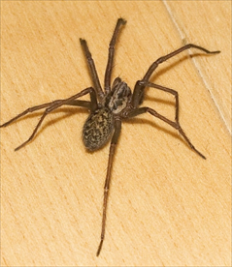Bug of the Month for October: Wolf Spider
Welcome to our Bug of the Month series.
It’s October, the time for Halloween. The Bug of the Month for October is the wolf spider! Wolf spiders are scary-looking spiders. Some species of wolf spider can get pretty big: over an inch in diameter! But don’t be too scared; their venom is not deadly to humans. The bite can be somewhat painful and can cause itching, but this is no cause for alarm. If wolf spiders are causing you a problem, here’s how to identify and get rid of them.
What do wolf spiders look like?
Wolf spiders are relatively large. Some species can be almost two inches long! They vary in color from grey to brown and are often confused with brown recluses.
One major way to tell the difference is the size. Brown recluses are smaller than wolf spiders. Wolf spiders also generally tend to be camouflaged or striped, while brown recluses have a violin-shaped dark spot reaching from the head to the back that resembles a violin.
Wolf spiders have two antennae reaching from the front of the mouth that can look like legs. Mother wolf spiders often carry their young on their backs until the young has grown enough to survive on its own.
What are some wolf spider behaviors?
Wolf spiders like to stay on the ground and will only climb when chasing prey. The same goes for swimming. Wolf spiders hunt alone and are never seen in packs.
Wolf spiders are more likely to retreat when they sense danger than attack, but wolf spiders can and will bite if they feel threatened. They also move very quickly. This helps them to both catch prey and retreat from danger.
Where do wolf spiders live?
Unlike many spiders, wolf spiders do not build webs. They are most often found on the ground where they hunt their prey. They tend to be nocturnal, but it is not uncommon to see them during the day.
They mostly stay outside, either in open fields or in piles of wood or brush. When they do come inside, they tend to stay around doors and windows or plants. They often remain on lower levels or even in basements and garages.
Autumn is the most likely time to find wolf spiders indoors. They migrate inside when the weather begins to change from warm to cold.
What should I do if I’m bitten by a wolf spider?
Although wolf spider venom is not deadly, the bite can be very painful. Medical attention should be sought because wolf spiders have been shown to cause allergic reactions.
After the pain subsides, the bite will become swollen and itchy. An antihistamine such as Benadryl can help greatly with this.
How can I get rid of wolf spiders?
To get rid of wolf spiders, you should try to safely remove the spider from your home. Since they are solitary spiders, it can be difficult to get rid of a bunch of them at once. To keep them from coming inside, try to seal windows and doorways and block off any holes or other entrances they can find to come inside.
If it is not possible to safely remove the spider, aerosol bombs and foggers are effective at removing the wolf spider indoors. If you want to get to them before they can even get inside, it is suggested that you use insecticides made specifically for spiders that can be found at most hardware stores.
If all else fails, contact a pest control company to exterminate the spiders.
There you have it, a comprehensive guide to identifying and eliminating wolf spiders. If the problem is too much for you to handle on your own, don’t hesitate to call Absolute Pest Control at (615)220-1933 or click here to schedule an appointment.
Source: http://pestcontrol.about.com/od/diyspidercontrol/a/The-Wolf-Spider-How-Dangerous-Is-It.htm



